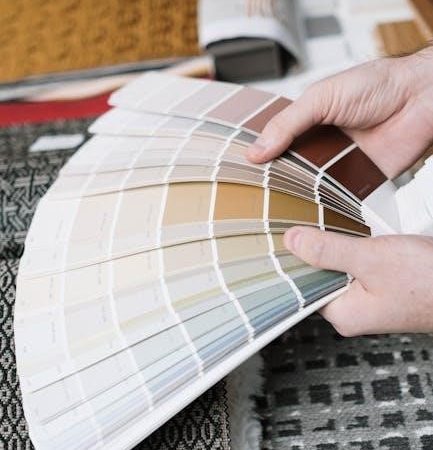makeup brush guide
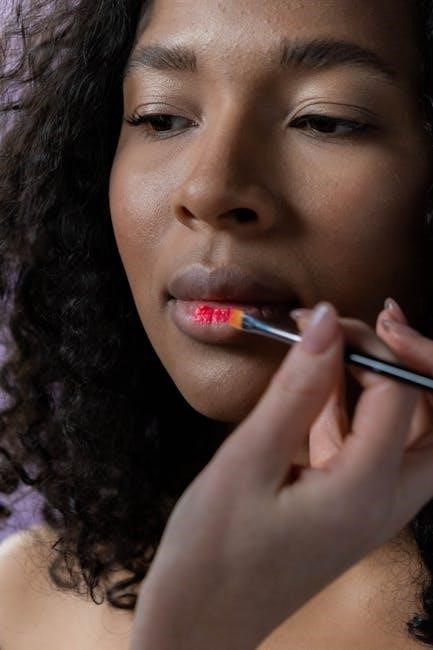
Makeup brushes are essential tools for enhancing beauty routines, offering precision and control. They come in various types, each designed for specific products and techniques, ensuring flawless application and natural finishes.
The Importance of Makeup Brushes in Beauty Routines
Makeup brushes play a pivotal role in enhancing beauty routines by providing precision, control, and a professional finish. They allow for even product distribution, blending, and targeted application, which fingers or sponges often cannot achieve. High-quality brushes elevate makeup results, ensuring a smooth, natural look. Whether applying foundation, concealer, or powder, the right brush can transform the outcome. Brushes are designed to work with specific products, optimizing their performance and longevity. Investing in quality tools not only enhances your routine but also extends the life of your makeup. Properly maintained brushes prevent bacteria buildup, ensuring hygiene and consistent results. Experts emphasize that while quality matters, understanding how to use each brush is key to unlocking their full potential. This makes them indispensable for both everyday use and advanced techniques.
A Brief History of Makeup Brushes
Makeup brushes have evolved significantly over centuries, with early versions crafted from natural materials like animal hair and wooden handles. Ancient civilizations, such as the Egyptians and Chinese, used rudimentary tools for applying cosmetics. These early brushes were simple yet functional, designed for basic powder and color application. In the Middle Ages, makeup use declined, but by the 20th century, the rise of Hollywood and the cosmetics industry spurred innovation. Synthetic fibers emerged, offering better hygiene and versatility. Today, makeup brushes are precision-crafted with advanced materials, catering to specific techniques and product types. Their history reflects a blend of tradition and modern technology, transforming them into indispensable tools for both everyday use and professional artistry.
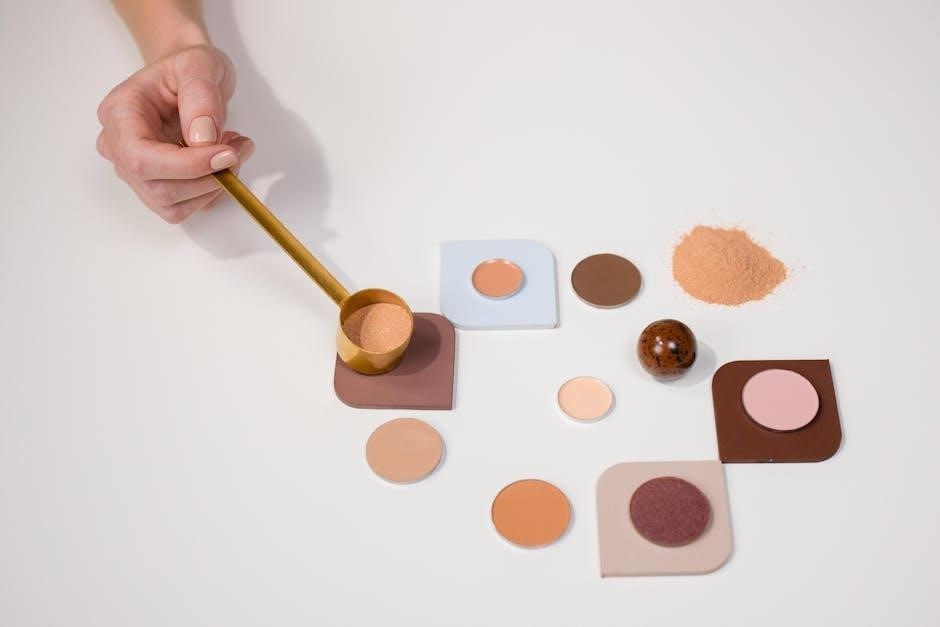
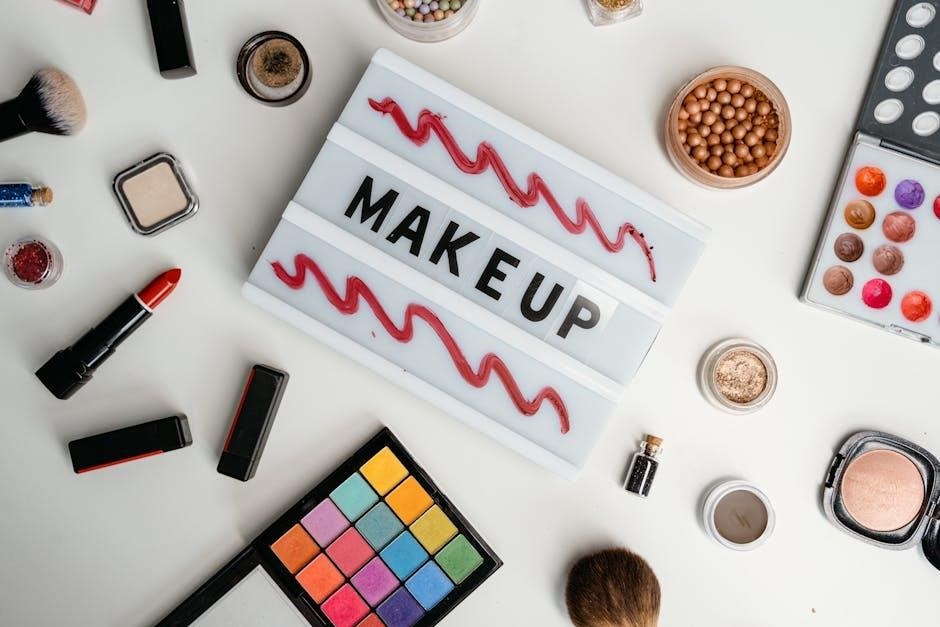
Types of Makeup Brushes
Makeup brushes are categorized by their use, including powder, blush, contour, and foundation brushes, each designed for specific functions in achieving a polished look.
Powder Brush
A powder brush is a large, fluffy tool used for applying loose or pressed powder. Its soft bristles ensure even coverage, helping to set makeup and reduce shine. Ideal for full-face application, it’s a must-have for creating a smooth, matte finish. Regular cleaning is essential to maintain its performance and prevent product buildup. Many makeup artists recommend using high-quality, synthetic bristles for better powder adherence and a seamless look. Whether you’re aiming for a light dusting or full coverage, a good powder brush is indispensable in any makeup routine.
Blush Brush
A blush brush is specifically designed for applying blush to the cheeks, creating a natural-looking flush. Typically smaller and more angled than a powder brush, it allows for precise placement on the apples of the cheeks. The soft bristles are ideal for picking up powder or cream blushes, ensuring even distribution of color. For a subtle look, use light, sweeping strokes upward and outward toward the temples. This technique helps blend the pigment seamlessly, avoiding harsh lines. Regular cleaning is essential to maintain the brush’s performance and prevent the buildup of product. A good-quality blush brush enhances the overall finish, giving cheeks a healthy, radiant appearance that complements any makeup look.
Contour Brush
A contour brush is designed for creating definition and depth in the face. It typically features a smaller, angled or tapered head, allowing for precise application of contour powder or cream along the hollows of the cheeks, jawline, and temples. The firm bristles are ideal for building shadow and creating a natural-looking contour. To use, sweep the brush in light strokes, following the natural curves of the face. This tool is essential for shaping and enhancing facial structure. For best results, choose a brush size that complements your face shape and ensure the bristles are densely packed for even product distribution. Regular cleaning is crucial to maintain its performance and prevent buildup; A contour brush is a must-have for achieving a defined, professional-looking makeup finish.
Bronzer Brush
A bronzer brush is specifically designed for applying bronzer to large areas of the face, such as the temples, cheekbones, and jawline, to create a sun-kissed glow. It typically has a larger, fluffy head with soft bristles to ensure even product distribution and blending. The angled or rounded shape allows for sweeping motions, making it easy to contour and add warmth to the face. For optimal results, use light strokes to build coverage gradually. This brush is ideal for both powder and cream bronzers. Proper cleaning and maintenance are essential to keep the bristles soft and prevent product buildup. A bronzer brush is a key tool for enhancing your natural complexion and achieving a radiant, healthy-looking finish. Regular use can help define facial features while maintaining a natural appearance.
Highlighter Brush
A highlighter brush is designed for precise application of highlighter to specific areas of the face, such as the high points of the cheekbones, brow bone, and cupid’s bow. Its smaller, tapered head allows for targeted placement, ensuring a subtle, radiant glow. The soft, densely packed bristles are typically made of synthetic materials to pick up and deposit shimmering products effectively. For a natural look, use light, dabbing motions to blend the highlighter seamlessly into the skin. This brush is versatile enough to work with both cream and powder highlighters. Regular cleaning is essential to maintain its performance and prevent the buildup of product residue. A highlighter brush is a must-have for creating dimension and adding luminosity to your makeup look, enhancing your features without appearing overly dramatic. Proper care ensures it remains a reliable tool in your beauty routine.
Foundation Brush
A foundation brush is a versatile tool designed for smooth, even application of foundation, ensuring a flawless base. It typically features flat or angled bristles, allowing for targeted coverage and blending. Synthetic bristles are ideal for liquid or cream foundations, as they hold and distribute the product effectively, while natural bristles may be better suited for powder foundations. To use, dampen the brush with a setting spray for a dewy finish or apply dry for full coverage. Gently sweep the brush across the face, starting from the center and blending outward toward the hairline and jawline. Regular cleaning is essential to maintain hygiene and prevent product buildup. A good foundation brush can elevate your makeup routine, providing a polished and professional finish that enhances your natural complexion. Proper care ensures longevity and optimal performance of the brush.
Concealer Brush
A concealer brush is a small, precise tool designed to target specific areas needing coverage, such as dark circles, blemishes, or scars. Its compact, often tapered head allows for accurate application, blending concealer seamlessly into the skin. Typically, concealer brushes feature synthetic bristles, which are ideal for cream or liquid concealers, ensuring smooth and even distribution. To use, dab a small amount of concealer onto the brush and gently pat it into the skin, feathering the edges for a natural look. Regular cleaning is essential to prevent bacteria buildup and maintain hygiene. A good concealer brush can help create a flawless base, making it a must-have for everyday makeup routines. Proper care and technique ensure optimal performance and longevity of the brush.
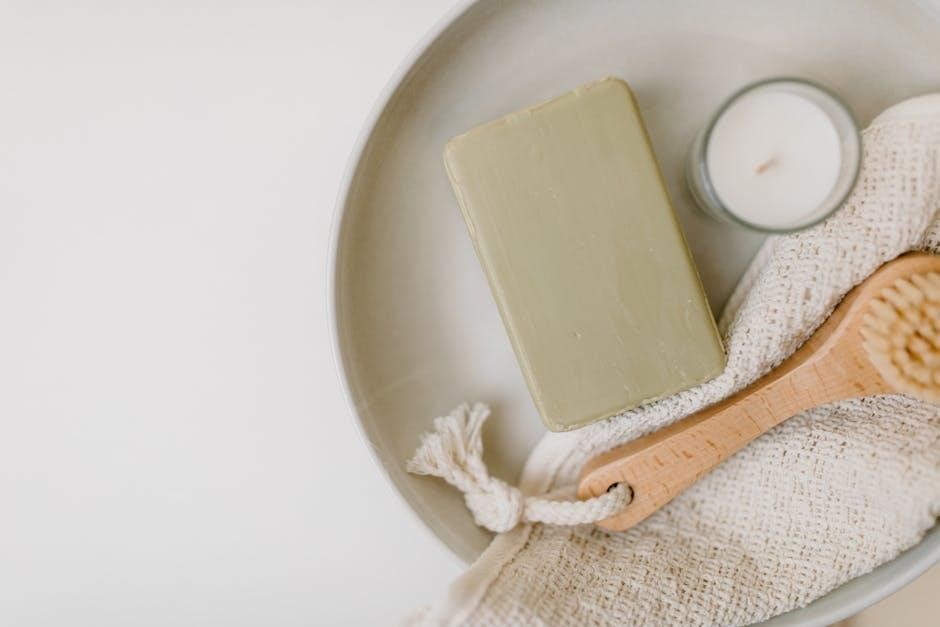
Stippling Brush
A stippling brush is a versatile tool with dual-tone or multi-colored bristles, designed for creating a natural, airbrushed finish. Its unique texture allows for precise application and blending of makeup. Use it to apply foundation, concealer, or cream products by lightly dabbing and blending in small, gentle motions. This technique helps build coverage gradually, ensuring a seamless look. The stippling brush is particularly effective for layering products without cakeiness. For best results, clean the brush regularly to maintain its performance and prevent product buildup. Ideal for those seeking a soft, natural base, the stippling brush is a valuable addition to any makeup collection, offering both precision and versatility in application.
Tapered Foundation Brush
The tapered foundation brush is a must-have for achieving a smooth, even base. Its pointed tip allows for precise application, especially around the eyes, mouth, and hairline, while the flat sides cover larger areas. Use it to blend foundation seamlessly, ensuring coverage in hard-to-reach spots. The brush works best with liquid or cream foundations, creating a natural, flawless finish. For optimal results, buff the product gently in circular motions. Regular cleaning is essential to maintain its performance and prevent bacteria buildup. This brush is ideal for those seeking accuracy and a polished look, making it a standout in any makeup collection.
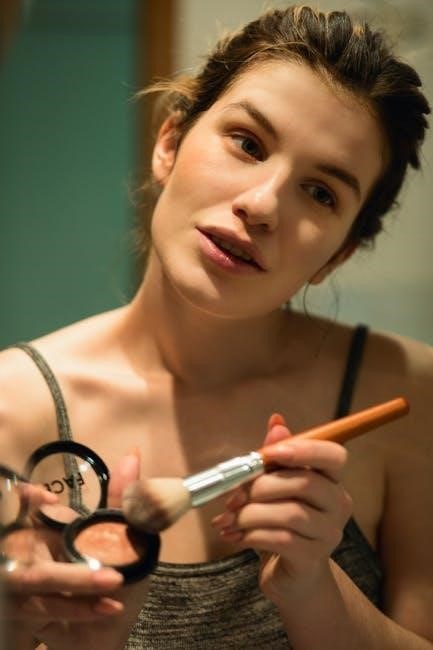
How to Choose the Right Makeup Brushes
Selecting the right makeup brushes involves considering your makeup goals, skin type, and brush materials. Quality and purpose-designed bristles ensure precise application and desired finishes effectively.
Understanding Brush Materials: Natural vs. Synthetic Bristles
Natural bristles, often from animals, are ideal for powders and blushes, offering soft texture and excellent pickup. Synthetic bristles, made from nylon or polyester, are best for creams and liquids, ensuring smooth application and easy cleaning. Natural fibers hold more product, while synthetic ones are hypoallergenic and durable. Choosing the right material depends on the type of makeup and personal preferences, ensuring optimal results and longevity of the brushes. Synthetic bristles are also vegan-friendly, making them a popular choice for ethical beauty routines. Proper care extends their lifespan, maintaining their performance over time. Both options cater to different needs, providing versatility for various makeup techniques.
Key Factors to Consider When Buying Makeup Brushes
When selecting makeup brushes, prioritize quality, material, and purpose. Natural bristles are best for powders, while synthetic fibers excel with creams. Handle ergonomics and balance are crucial for control. Cost varies, but investing in durable, well-made brushes ensures longevity. Consider your skill level—beginners may prefer starter sets, while professionals need specialized tools. Look for brushes tailored to specific products, like foundation or concealer, for optimal results. Additionally, ethical considerations, such as vegan-friendly synthetic options, may influence your choice. Always read reviews and seek recommendations to ensure you’re purchasing brushes that meet your needs and budget. Proper care and maintenance will extend their lifespan, making them a worthwhile investment for any beauty routine.

Essential Makeup Brushes for Beginners
Essential makeup brushes for beginners include a powder brush for even coverage, a tapered foundation brush for smooth base application, a concealer brush for precise spot coverage, a blush brush for adding color, and a bronzer/highlighter brush for definition. These versatile tools help create a natural, polished look every time.
Must-Have Brushes for Everyday Use
For everyday use, essential brushes include a powder brush for setting makeup, a foundation brush for smooth base application, a concealer brush for targeted coverage, a blush brush for adding color, and a bronzer/highlighter brush for contouring. These tools are versatile and help achieve a natural, polished look. A stippling brush can also be useful for blending foundation and concealer seamlessly. Investing in quality brushes ensures better product application and longevity of your makeup. Whether you prefer a minimalist routine or a more detailed look, these must-have brushes will streamline your daily beauty process and enhance your overall results.
How to Build a Basic Makeup Brush Collection
Building a basic makeup brush collection starts with investing in quality over quantity. Focus on versatile tools like a powder brush for setting makeup, a foundation brush for smooth base application, and a concealer brush for targeted coverage. Add a blush brush for adding color to the cheeks and a bronzer/highlighter brush for contouring. These essentials cover the fundamentals of daily makeup application. Consider adding a contour brush and a highlighter brush for more definition. Store your brushes properly to maintain their condition, and clean them regularly to ensure hygiene and longevity. With these basics, you’ll have everything needed to create a variety of everyday looks.
Cleaning and Maintaining Makeup Brushes
Regularly cleaning your makeup brushes with warm water and mild soap keeps them in great condition. Gently massage bristles, rinse thoroughly, and air-dry to prevent damage. Proper maintenance ensures longevity and hygiene.
Step-by-Step Guide to Cleaning Makeup Brushes
Cleaning your makeup brushes is essential for maintaining hygiene and brush longevity. Start by dampening the bristles with warm water. Apply a small amount of mild shampoo or brush cleanser to the palm of your hand. Gently massage the bristles in a circular motion to remove makeup and impurities. Rinse under running water until the water runs clear. Reshape the brush and lay it flat or hang it to air-dry. Avoid soaking the ferrule or handle. For quick cleaning, use a spray cleanser and wipe the bristles on a tissue. Regular cleaning prevents bacteria buildup and ensures smooth makeup application. Clean your brushes weekly for optimal results.
How to Properly Store Makeup Brushes
Proper storage of makeup brushes is crucial for maintaining their quality and longevity. Store brushes in a cool, dry place, away from direct sunlight to prevent bristle damage. Use protective cases or pouches to shield them from dust and accidental bending. For upright storage, place brushes in a cup or container with the bristles facing upward to avoid flattening. Avoid storing brushes in humid environments, as this can lead to mold or bacteria growth. Consider using brush guards to maintain the shape of the bristles. Regularly cleaning and storing brushes in an organized manner ensures they remain hygienic and functional. Proper storage not only extends the life of your brushes but also keeps them in optimal condition for flawless makeup application.
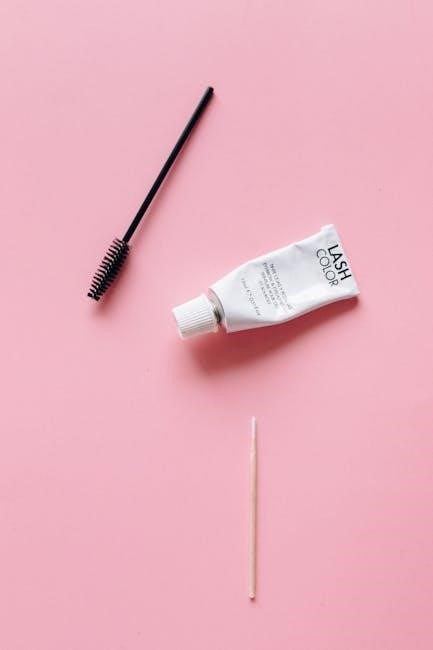
Advanced Makeup Brush Techniques
Mastering advanced techniques enhances makeup application. Contouring, highlighting, and blending require precision. Use angled brushes for sharp lines and fluffy brushes for soft transitions. Expert tips refine your skills for professional results.


Mastering Contouring and Highlighting with Brushes
Contouring and highlighting are transformative techniques that shape and brighten the face. Use angled contour brushes to define cheekbones and jawlines, while smaller, precise brushes target under-eye areas. For highlighting, flat or domed brushes apply product smoothly to high points like the tops of cheekbones, brow bones, and cupid’s bow. Blending is key—soft, feathery strokes merge contours and highlights seamlessly. Expert makeup artists recommend layering for natural depth and dimension. Proper brush selection ensures precise application, enhancing facial features effectively. Regular practice perfects the technique, creating a polished, professional finish. Elevate your makeup game with these essential contouring and highlighting skills for a radiant, sculpted look.
Blending Techniques for Flawless Makeup
Blending is a cornerstone of seamless makeup application. Use fluffy, domed brushes to soften harsh lines and merge colors effortlessly. Start with light, sweeping strokes to blend base layers, then build coverage as needed. For precise areas, like the crease or under-eye, opt for smaller, pointed brushes. Feathering edges ensures a natural transition between shades. A light hand is key to avoiding cakey finishes—blend upward and outward for a lifted, radiant effect. Regular practice hones this skill, making it second nature. Blending transforms makeup from ordinary to extraordinary, creating a polished, professional finish. Mastering this technique elevates your makeup game, ensuring every look is flawless and effortlessly stunning.
Expert Tips and Tricks
Experts emphasize investing in quality brushes for optimal results. Proper cleaning, using gentle cleansers, and storing upright prevents damage. Regularly sanitizing extends brush life and maintains hygiene.
One of the most frequent mistakes is using the wrong brush for the product, leading to uneven application. Overloading the brush with excess product can result in a heavy, cakey finish. Neglecting to clean brushes regularly allows bacteria to buildup, causing breakouts and reducing brush performance. Storing brushes improperly, such as laying them flat, can damage the bristles and ferrule. Additionally, applying too much pressure can irritate the skin and distort the brush shape. Using the same brush for multiple products without cleaning can mix colors and reduce precision. Avoiding these mistakes ensures better makeup results and extends the life of your brushes. Professional makeup artists swear by several brush hacks to enhance their work. One popular hack is lightly spraying brushes with setting spray before use to ensure product adheres evenly. Another is using the “damp, not wet” technique for foundation and concealer to achieve a smooth finish. For precise contouring, artists often carve out cheekbones with the back of a contour brush before blending. Storing brushes in protective cases prevents damage, while fluffing bristles after cleaning restores their shape. Experts also recommend repurposing older brushes for less critical tasks, like applying setting powder. These hacks optimize brush performance, extend their lifespan, and elevate makeup artistry to new levels. Investing in quality makeup brushes and mastering proper techniques can elevate your beauty routine, ensuring professional results and long-lasting confidence in your makeup application skills. Choosing the right makeup brushes is a crucial step in achieving professional-looking results. Quality brushes ensure better product application and longevity, while proper techniques enhance overall makeup looks. Understanding the differences between natural and synthetic bristles, as well as the specific uses of each brush type, can transform your beauty routine. Regular cleaning and proper storage are essential for maintaining brush performance and hygiene. Whether you’re a beginner or an advanced user, investing in a well-rounded collection of essential brushes will elevate your makeup game. Remember, it’s not just about the tools but how you use them. Experiment with techniques, embrace innovation, and enjoy the creative process of makeup artistry. The future of makeup brushes is poised for exciting advancements, with a focus on sustainability and technology. Eco-friendly materials, such as recycled bristles and biodegradable handles, are expected to gain prominence. Additionally, antibacterial and self-cleaning brushes could become mainstream, offering enhanced hygiene. Personalization is another trend, with 3D-printed brushes tailored to individual face shapes and preferences. Smart brushes equipped with sensors to monitor product usage and application techniques may also emerge. Furthermore, advancements in brush ergonomics and handle design could improve usability for diverse needs; These innovations aim to blend functionality, sustainability, and inclusivity, ensuring makeup brushes evolve to meet modern beauty standards and consumer demands.Common Mistakes to Avoid When Using Makeup Brushes
Professional Makeup Artists’ Favorite Brush Hacks
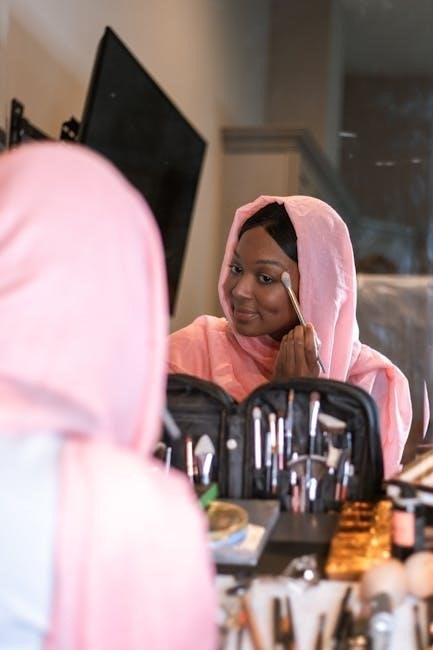
Final Thoughts on Choosing and Using Makeup Brushes
Future Trends in Makeup Brush Innovation


